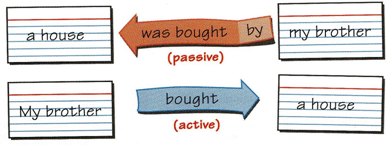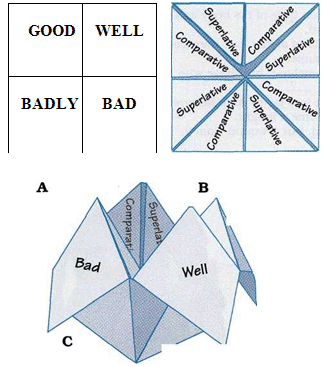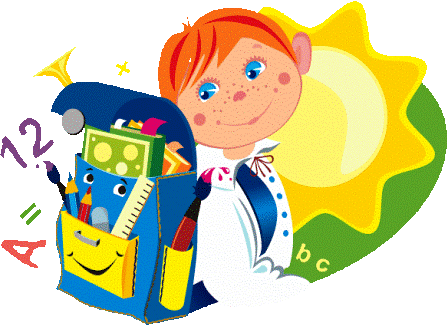Practice forming the comparative and superlative forms by doing the following activity:
Cut out a piece of paper approximately 8 cm x 18cm. Fold two sides in to form shutters, as shown in the illustration, leaving a space in the middle. Cut two slots about 3cm wide, as shown. Under the left shutter, write more and most Under the right shutter, write -er and -est.
On a strip of paper about 2,5cm wide, list adjectives and adverbs, such as clear, precious, just, incredible, arbitrarily, slow, meaningful, dirty, strict, clever. Feed the strip of paper through the slots as shown, making sure that a word shows in the window.
Now, decide whether the modifier forms its comparative and superlative degrees with more and most or with -er and -est First, close the right shutter to cover up -er and -est, and say the word with more and with most. Then, close the left shutter, and try the word with -er and -est. By always closing one shutter, you will avoid forming a double comparison. Decide how the comparative and superlative degrees are formed. If you are unsure, consult a dictionary.
Active Arrows and Passive Points

You should write most sentences in the active voice unless you want to emphasize the receiver of an action or you are not indicating the performer of an action. To practice revising sentences by changing them from passive to active voice, do the following activity:
Cut out several arrows, similar to the ones shown below. On the side of an arrow pointing to the right, write a past tense form of a verb. Examples: addressed, bought, drew, knew, saw.
Flip the arrow over so that it points to the left. Write the same verb in the passive voice. (Remember that a passive voice verb includes a form of be and a past participle.) Examples: has been addressed, was bought, are drawn, was known, has been seen. Fold the flat end of the arrow, and write the word by on it, to be hidden or revealed as needed.
Next, take two equal piles of index cards. On each card in one pile, write a performer of an action—a boy, an anthropologist, a scientist, my brother. On each card in the other pile, write a noun that can receive the action—a house, a pyramid, a fossil, the portrait.
Working alone or with a partner, place a receiver and a performer card words up, with a space between them. Choose an arrow to fill the space. Point the arrow toward the receiver of the action. Read this passive voice sentence. Then, flip the arrow over, and shift the two index cards to create a new active voice sentence. Your second sentence should be shorter and more direct. Experiment by creating some sentences in your fold under the word by and do not state the performer of the action. Note that these sentences must stay in the passive voice.
Irregular-Modifier Pocket Fold
Practice using irregular comparative and superlative forms of modifiers with a pocket fold. Take a 15 cm-square sheet of paper, and fold in the corners so that they meet in the middle. Turn the paper over, and again fold in the corners. Then, crease the paper by folding it in half and in half again. You will have a small square. Unfold only the small square, and lay the paper flat so that four square sections are facing upward. Write the positive degree of a different irregular modifier on each of the four squares. (See example A.) Next, turn the paper over, and on each of the eight triangular sections, write comparative or superlative. (See example B.) Then, lift up each triangle, and write underneath it the corresponding forms of the comparative or superlative on the back of the square. Each modifier will have two forms.
Finally, refold the square so that the positives are on the outside. Place your thumbs and index fingers in each of the four slots formed by the small squares, and pinch them together. You should be able to open and close the square in two directions, exposing either the comparative or the superlative form each time. (See example C.)
With a partner, take turns choosing a modifier from the other's pocket fold. After opening and closing the square in different directions four or five times, each person must give the form of the modifier indicated on the triangle. Check your answers by lifting up the triangle.

Pronoun Sentence Slide
To help you see how the use of a pronoun in a sentence determines its case, complete the following activity. Fold a sheet of paper in half lengthwise. Make several cuts, approximately 5 cm apart, from the fold to the open edge. Do not cut all the way to the open edge.
Next, cut from index cards or construction paper pronoun slides. For each pronoun, cut one card as shown. On one side of the card, write the nominative case. On the other side, write the objective case.
Unfold the paper, and write a sentence along each cut. Use a proper noun at each end of the sentence—in some sentences, have the second proper noun be the subject of a clause; in others, the object. Both nouns should be the same number and gender. Use the pronoun slide to cover and replace the noun acting as the subject. Then, slide the pronoun to the other end of the sentence to replace the object. Flip the card to show the objective case.
Strip Out Double Negatives

Fan-fold a long, narrow strip of paper to create at least fifteen sections. Leave the first, or top, section blank. In each following section of the strip, write a negative word. You may choose to use -n't on the "not" section to remind you that contractions formed with not are negative words, or you may list each negative contraction on its own section. When you are finished listing negative words, fold the strip and label the front "Negative Words." Use the strip to help you check for double negatives when you proofread.
One strategy you can use when proofreading is to put an Xon each negative word you find in your writing. If you see two words with an Xin any sentence, evaluate whether both negative words are needed.
Notice that two words on the list are crossed out of the sentence. To restore the intended meaning of the sentence, no is replaced with any.

